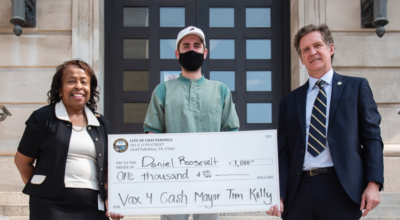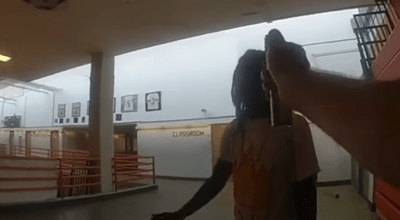
CHATTANOOGA, Tenn., Sept. 19, 2022 – A government-sponsored mass casualty event in Hamilton County can be halted and prosecuted by two parties.
By David Tulis / NoogaRadio 96.9 FM
One is Coty Wamp, the newly elected district attorney getting her staff together and settling into office after being sworn in Sept. 1.
The other is the grand jury. It has a high calling and noble history, but has been debased and emasculated by district attorneys for decades, and by public schooling and other suppressors of independent thinking favoring liberty and prosperity.
Which party is likely to act first to act in a mass fraud and mass medical terror activity that today has a registered death toll of 990 people and reports of 12,747 jab harms? These numbers of harms are in a federal government report, and no official body in Hamilton County is moved with alarm to correct the great evil causing them.
Calculations about underreporting put deaths at 100x more. Death in Tennessee from the Covid-19 shots are more like 99,000 people, and harms at 1.27 million, assuming that 100x underreporting factor. Steve Kirsch of Vaccine Safety Research Foundation says all data suggest a URF of 41x, which gives lower figures of 40,590 deaths in Tennessee and 522,627 injuries.
The blame for these deaths is upon government officials and agencies, starting with Gov. Bill Lee. In Hamilton County, the leading figures in the redefinition of public health are Jim Coppinger, former county mayor; Andy Berke, former Chattanooga mayor; and the current mayors of these municipalities, Weston Wamp in the county and Tim Kelly in the city. Also, the health department now led by Sabrena Novak is a key player in violating T.C.A. 68-5-104, the infectious disease law.
It is doubtful the new Hamilton County district attorney, Coty Wamp, is on the prowl for criminal activity (violation of law) among her establishment peers or former peers. It is fair to say the county’s two grand juries are not.
Our emasculated grand jury
The grand jury has long lost its original powers to investigate crime and wrongdoing by officials. It has lost its independence from the state and from the courts. Grand juries originally were government spoilers in misfeasance, malfeasance, rights abuse, bribery, crime and corruption in government. Legal historian Roger Roots tells how federal juries became tools of prosecutors in his essay, “If It’s not a Runaway, it’s not a Real Grand Jury,” 1999, and generally in his book, Conviction Factory; the Collapse o America’s Criminal Courts, 2014.
“Today’s gargantuan criminal justice landscape,” Roots says in the book, “with its hundreds of penal institutions and expansive offender registries, could not have been possible but for the jury’s decreased role as a check on the power of the state. And because juries are no longer allowed to openly cast votes against bad laws, the criminal codes of every American jurisdiction have exploded in length, triviality and complexity” (p. 113). Quoting an authority, Roots says “the present-day jury is only a shadow of its former self,” marginalized by plea bargaining and the jury’s conversion to “mere evaluators of facts.”
In Hamilton County, panel members are “guided” by their foremen and by the DA’s office, as a sow by a nose ring. The indictments they issue are 1/13th unconstitutional on the basis of the foreman being named apart from the random selection process, yet that person having a vote on indictments. If any given indictment is so marred, it is fair to say, that indictment can be challenged on subject matter jurisdiction grounds at any time, even post conviction, by any person, as unconstitutional and subject to being thrown out.
Two grand jury reports published in Chattanoogan.com tell of the lamentable state of a once-powerful government-spoiler body, and of the people in their level of knowledge and character.
The grand jury might as well not exist in Hamilton County, as it “rubber stamps” officer accusations nearly 100 percent of cases. Of 357 cases presented to the regular grand jury led by Jimmy Anderson, “we returned 356 true bills, 50 presentments, and 1 no bill[]. Jurors found that the vast majority of cases presented were sufficiently detailed to meet the probable cause standard.”
The rate of indictment is 99.75 percent of cases presented. The indictment rate of the concurrent grand jury, detailed below, is slightly less. It’s 98.74 percent.
The group says it is “very fortunate” to have ADA Jerry Sloan assigned to the body “to provide insight and expertise to facilitate our understanding of the charges and applicable laws and statues.”
Because grand juries are controlled by the county’s three judges and “aided” by the prosecutors, they see nothing amiss in crimes by government agencies or state actors. Grand jury reports indicate they look only at crime by citizens.
The supreme court’s closure of the courts March 13, 2020, in the admitted fraud by Gov. Bill Lee left people in jail without relief for months on end, the jury report suggests. The jurors heard cases from “as far back as 2017, 2018 and 2019. “The possibility that some of these individuals could be incarcerated the entire time that their cases meander through the system is problematic.”
Police and deputies seem to put grand jurors in awe. Cops are usually the witness bringing an indictment that tells a defendant that he is going to be put on trial. “During the course of these four months, we developed a deeper appreciation and admiration for the work that these individuals do” to “protect and serve our neighborhoods and communities. We are indebted to them and their families for their dedication, service, and sacrifice.”
The grand jury indicts people without having officers always personally testify. “It was rare to encounter a witness that was unable to answer the questions or provide information deemed necessary by the grand jury. Witness narratives and affidavits were generally detailed and well-written, which was especially helpful when the arresting officer was not present and their affidavit was read by another individual.” Without the chief accuser, the jurors cannot press doubts or questions as to whether the law is rightly applied.
Grand jurors meet two days every other week — which seems like a light schedule. They hear only cops and officers, without a perjury-trapping record being made. Cops are notorious for lying, but no record is kept to catch them when perjury comes to the fore at trial. “We appreciated witnesses that brought videos and photos to enhance their testimonies.”
Local agencies take part in the federal war on drugs, using state law to prosecute members of the public who trade in narcotics or use them. “It is important for jurors to have a clear understanding of the law and the legal ramifications of their decisions,” they say. “
We relied heavily on the Assistant District Attorney to provide that needed guidance and explanation, but it would be beneficial if some of that information is readily available in written form. We recommend providing a simple document (brochure, trifold, etc.) with a brief explanation of applicable laws and statutes, a visual chart showing charges and consequences, etc. We also recommend that instead of blank sheets of paper for note-taking, that there be a basic template provided for juror note-taking” with blocks for officer name, time and date of offense and nature of charges.
Reports indicate that grand jurors in Tennessee are misled by officers citing a part of a statute, when if they could read a provision in its entirety and context, they would see the charge as abusive and without foundation.
Grand jurors soak in what they hear from police. Sometimes, they come to life. “On few occasions the arresting officers were asked to provide additional information before the Grand Jury was confident in making a determination.”
The jurors whose comments are cited are filled with goodwill. “We were united by a shared desire to exercise our civic responsibility with the utmost integrity,” says one, “a heightened awareness of the issues afflicting our community and society; and a deeper sense of responsibility for addressing those issues.”
The closing comment of the May-August grand jury suggests members are highly serviceable and reliable for the operation of the police-industrial complex. “We wish to reiterate our gratitude to the support staff, judicial personnel, law enforcement officers, and to each other for creating a safe space where we could openly express our thoughts, views, and opinions.”
Patrician lawyer leads 2nd grand jury
The control of the grand jury under the hand of government players is equally evident in the county’s concurrent grand jury. A report on this second bodyJanuary to April 2022 heaps praises on Hugh Moore, a former prosecutor and lawyer at a big local law firm, and prosecutor Kate Lavery, “who is assigned” to the body.
One grand juror says Mrs. Lavery is “invaluable to help guide us and understand the process and our responsibilities.”
The compliance with this grand jury with prosecutorial interest also staggers. It heard 478 cases, twice the number as January to April. There were 389 true bills, 83 presentments.
There were six no bills.
The rate of indictment is 99.75 percent of cases presented. The indictment rate of the concurrent grand jury is 98.74 percent.
She and the Chattanooga police department “deserve gold stars” for getting police agencies to designate one person to organize submissions of criminal complaints.
“Very few of the Jurors have any familiarity with the criminal justice system,” says Mr. Moore, the foreman. They make the most of presentations by the judges – Tom Greenholtz, Don Poole, Barry Steelman, Alex McVeigh (two of whom had moved on to other jobs or retirement) – and the sheriff, then Jim Hammond. Jurors were “impressed with the professionalism” of the officers who trooped by with accusatory testimony.
Mr. Moore quotes a juror considering a complex investigations. The person is thankful for the “painstaking and intricate detective work that went into unraveling several very complex cases. The persistence and attention to detail shown by these officers is remarkable.”
Long delay in getting lab results back from TBI doesn’t help wrapping up cases. Says the juror, “The overwhelming volume of cases amazed me ***. Some days it felt like no matter how many cases we heard, we barely made a dent in the stack of cases waiting to be presented. The general public only sees or hears about the headline cases, but not the hundreds of cases that are just as important, but fly under the radar.”
Juror highlights prosecutor’s ‘help’
The control of the district attorney’s office is met with thanks. Says one juror, a disabled person lamenting the F$13 daily wage for the public service, “was relieved to learn upon selection that there was a Grand Jury Prosecutor who was assigned to our jury, and who would be in the room with us. Even if it was only during testimony, we had someone there to help us cut through any legal sludge we might get bogged down in.”

